FORD FUSION HYBRID 2014 Owners Manual
Manufacturer: FORD, Model Year: 2014, Model line: FUSION HYBRID, Model: FORD FUSION HYBRID 2014Pages: 473, PDF Size: 5.93 MB
Page 231 of 473
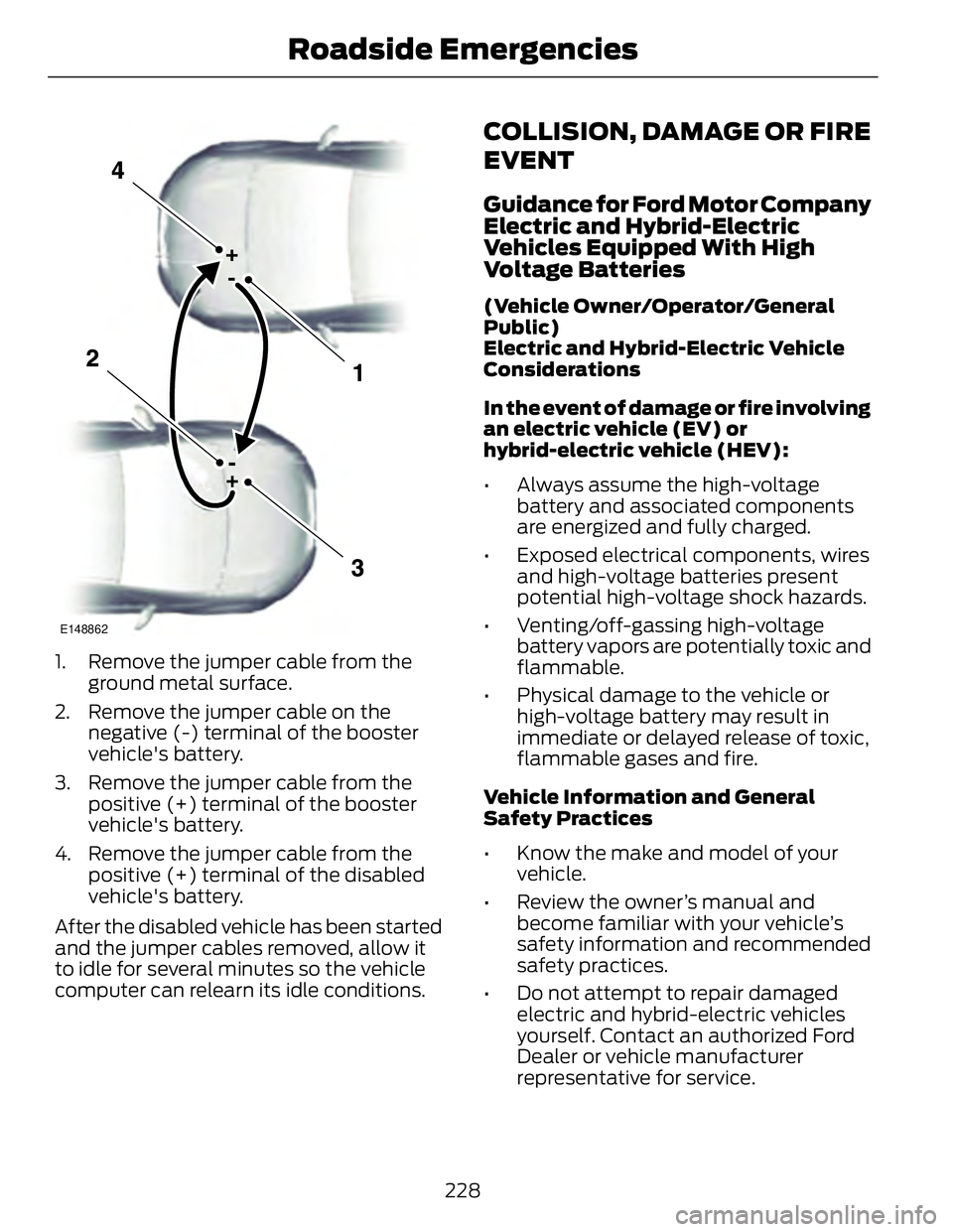
E148862
1. Remove the jumper cable from the
ground metal surface.
2. Remove the jumper cable on the
negative (-) terminal of the booster
vehicle's battery.
3. Remove the jumper cable from the
positive (+) terminal of the booster
vehicle's battery.
4. Remove the jumper cable from the
positive (+) terminal of the disabled
vehicle's battery.
After the disabled vehicle has been started
and the jumper cables removed, allow it
to idle for several minutes so the vehicle
computer can relearn its idle conditions. COLLISION, DAMAGE OR FIRE
EVENT Guidance for Ford Motor Company
Electric and Hybrid-Electric
Vehicles Equipped With High
Voltage Batteries (Vehicle Owner/Operator/General
Public)
Electric and Hybrid-Electric Vehicle
Considerations
In the event of damage or fire involving
an electric vehicle (EV) or
hybrid-electric vehicle (HEV):
• Always assume the high-voltage
battery and associated components
are energized and fully charged.
• Exposed electrical components, wires
and high-voltage batteries present
potential high-voltage shock hazards.
• Venting/off-gassing high-voltage
battery vapors are potentially toxic and
flammable.
• Physical damage to the vehicle or
high-voltage battery may result in
immediate or delayed release of toxic,
flammable gases and fire.
Vehicle Information and General
Safety Practices
• Know the make and model of your
vehicle.
• Review the owner’s manual and
become familiar with your vehicle’s
safety information and recommended
safety practices.
• Do not attempt to repair damaged
electric and hybrid-electric vehicles
yourself. Contact an authorized Ford
Dealer or vehicle manufacturer
representative for service.
228Roadside Emergencies
Page 232 of 473
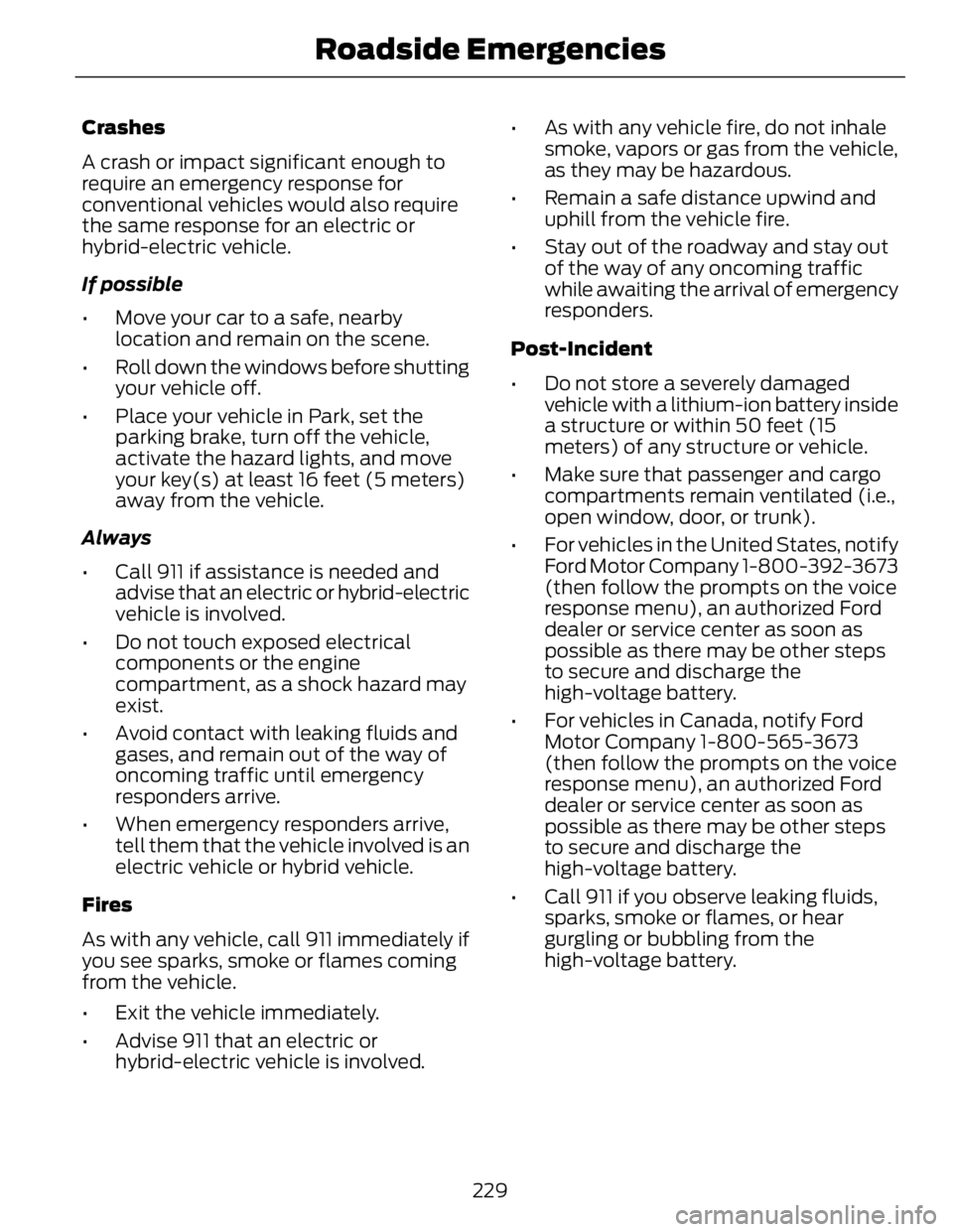
Crashes
A crash or impact significant enough to
require an emergency response for
conventional vehicles would also require
the same response for an electric or
hybrid-electric vehicle.
If possible
• Move your car to a safe, nearby
location and remain on the scene.
• Roll down the windows before shutting
your vehicle off.
• Place your vehicle in Park, set the
parking brake, turn off the vehicle,
activate the hazard lights, and move
your key(s) at least 16 feet (5 meters)
away from the vehicle.
Always
• Call 911 if assistance is needed and
advise that an electric or hybrid-electric
vehicle is involved.
• Do not touch exposed electrical
components or the engine
compartment, as a shock hazard may
exist.
• Avoid contact with leaking fluids and
gases, and remain out of the way of
oncoming traffic until emergency
responders arrive.
• When emergency responders arrive,
tell them that the vehicle involved is an
electric vehicle or hybrid vehicle.
Fires
As with any vehicle, call 911 immediately if
you see sparks, smoke or flames coming
from the vehicle.
• Exit the vehicle immediately.
• Advise 911 that an electric or
hybrid-electric vehicle is involved. • As with any vehicle fire, do not inhale
smoke, vapors or gas from the vehicle,
as they may be hazardous.
• Remain a safe distance upwind and
uphill from the vehicle fire.
• Stay out of the roadway and stay out
of the way of any oncoming traffic
while awaiting the arrival of emergency
responders.
Post-Incident
• Do not store a severely damaged
vehicle with a lithium-ion battery inside
a structure or within 50 feet (15
meters) of any structure or vehicle.
• Make sure that passenger and cargo
compartments remain ventilated (i.e.,
open window, door, or trunk).
• For vehicles in the United States, notify
Ford Motor Company 1-800-392-3673
(then follow the prompts on the voice
response menu), an authorized Ford
dealer or service center as soon as
possible as there may be other steps
to secure and discharge the
high-voltage battery.
• For vehicles in Canada, notify Ford
Motor Company 1-800-565-3673
(then follow the prompts on the voice
response menu), an authorized Ford
dealer or service center as soon as
possible as there may be other steps
to secure and discharge the
high-voltage battery.
• Call 911 if you observe leaking fluids,
sparks, smoke or flames, or hear
gurgling or bubbling from the
high-voltage battery.
229Roadside Emergencies
Page 233 of 473
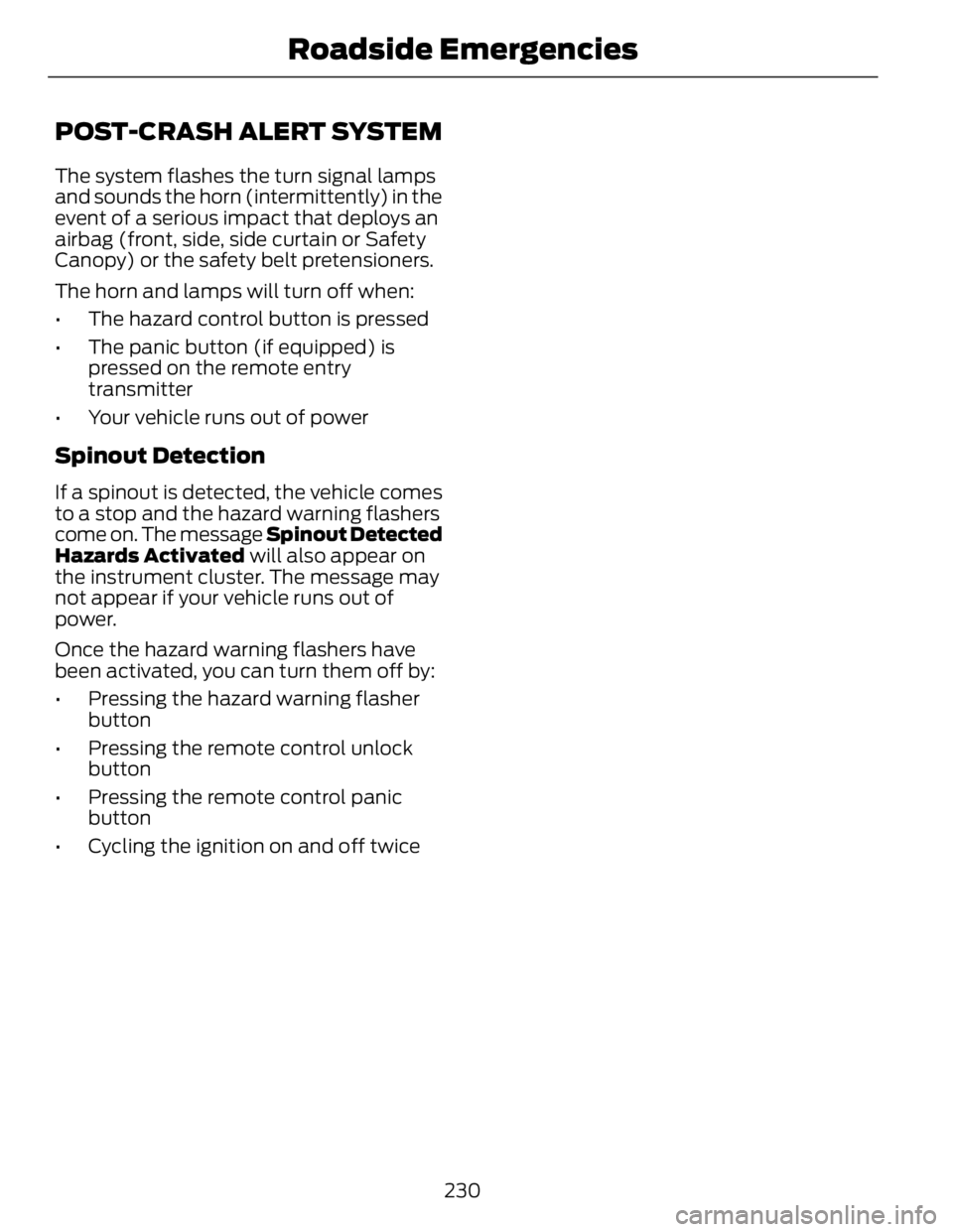
POST-CRASH ALERT SYSTEM The system flashes the turn signal lamps
and sounds the horn (intermittently) in the
event of a serious impact that deploys an
airbag (front, side, side curtain or Safety
Canopy) or the safety belt pretensioners.
The horn and lamps will turn off when:
• The hazard control button is pressed
• The panic button (if equipped) is
pressed on the remote entry
transmitter
• Your vehicle runs out of power
Spinout Detection If a spinout is detected, the vehicle comes
to a stop and the hazard warning flashers
come on. The message Spinout Detected
Hazards Activated will also appear on
the instrument cluster. The message may
not appear if your vehicle runs out of
power.
Once the hazard warning flashers have
been activated, you can turn them off by:
• Pressing the hazard warning flasher
button
• Pressing the remote control unlock
button
• Pressing the remote control panic
button
• Cycling the ignition on and off twice
230Roadside Emergencies
Page 234 of 473
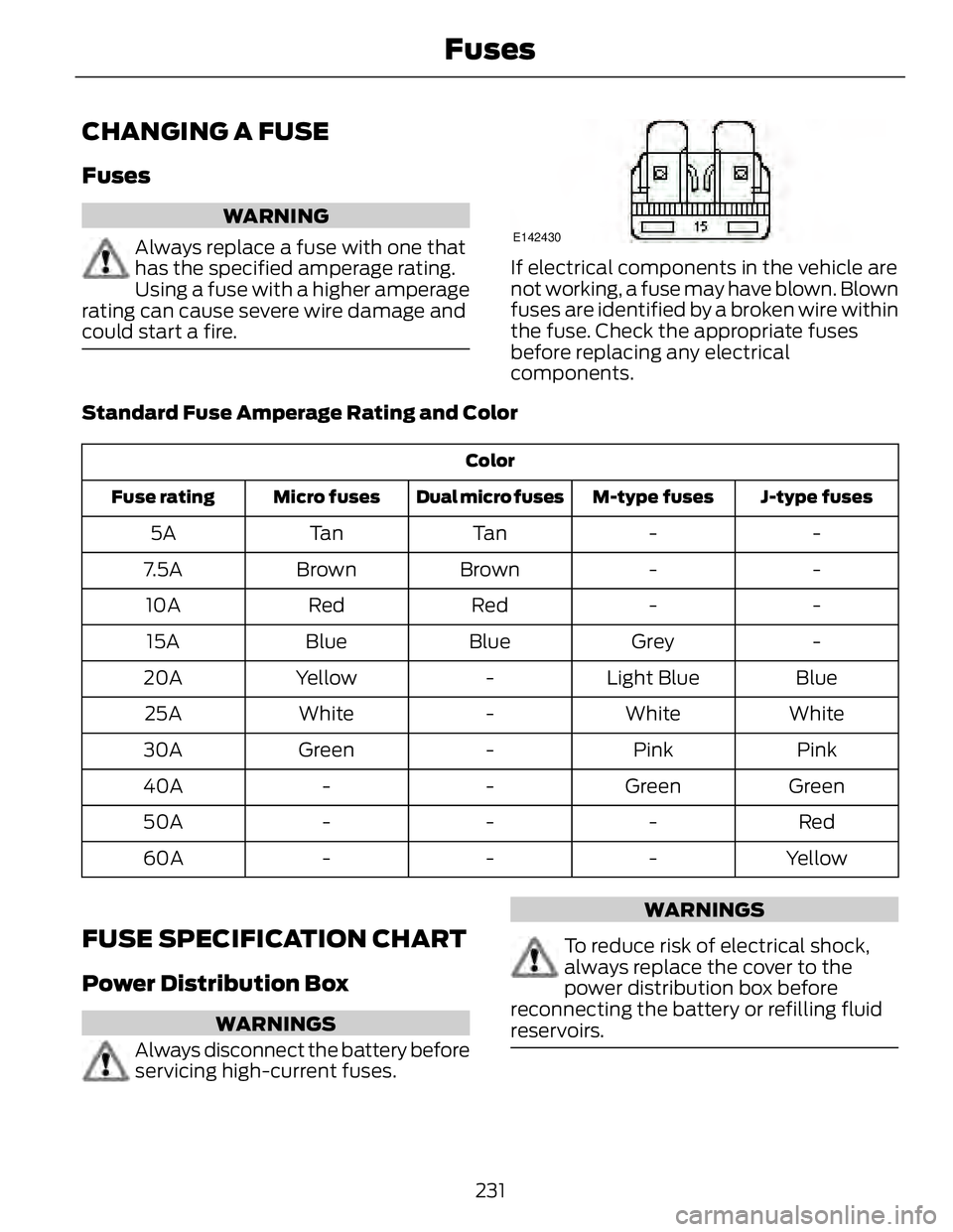
CHANGING A FUSE Fuses WARNING
Always replace a fuse with one that
has the specified amperage rating.
Using a fuse with a higher amperage
rating can cause severe wire damage and
could start a fire. E142430
If electrical components in the vehicle are
not working, a fuse may have blown. Blown
fuses are identified by a broken wire within
the fuse. Check the appropriate fuses
before replacing any electrical
components.
Standard Fuse Amperage Rating and Color Color
J-type fusesM-type fusesDual micro fusesMicro fusesFuse rating
--Ta nTa n5A
--BrownBrown7.5A
--RedRed10A
-GreyBlueBlue15A
BlueLight Blue-Yellow20A
WhiteWhite-White25A
PinkPink-Green30A
GreenGreen--40A
Red---50A
Yellow---60A
FUSE SPECIFICATION CHART
Power Distribution Box
WARNINGS
Always disconnect the battery before
servicing high-current fuses. WARNINGS
To reduce risk of electrical shock,
always replace the cover to the
power distribution box before
reconnecting the battery or refilling fluid
reservoirs.
231Fuses
Page 235 of 473
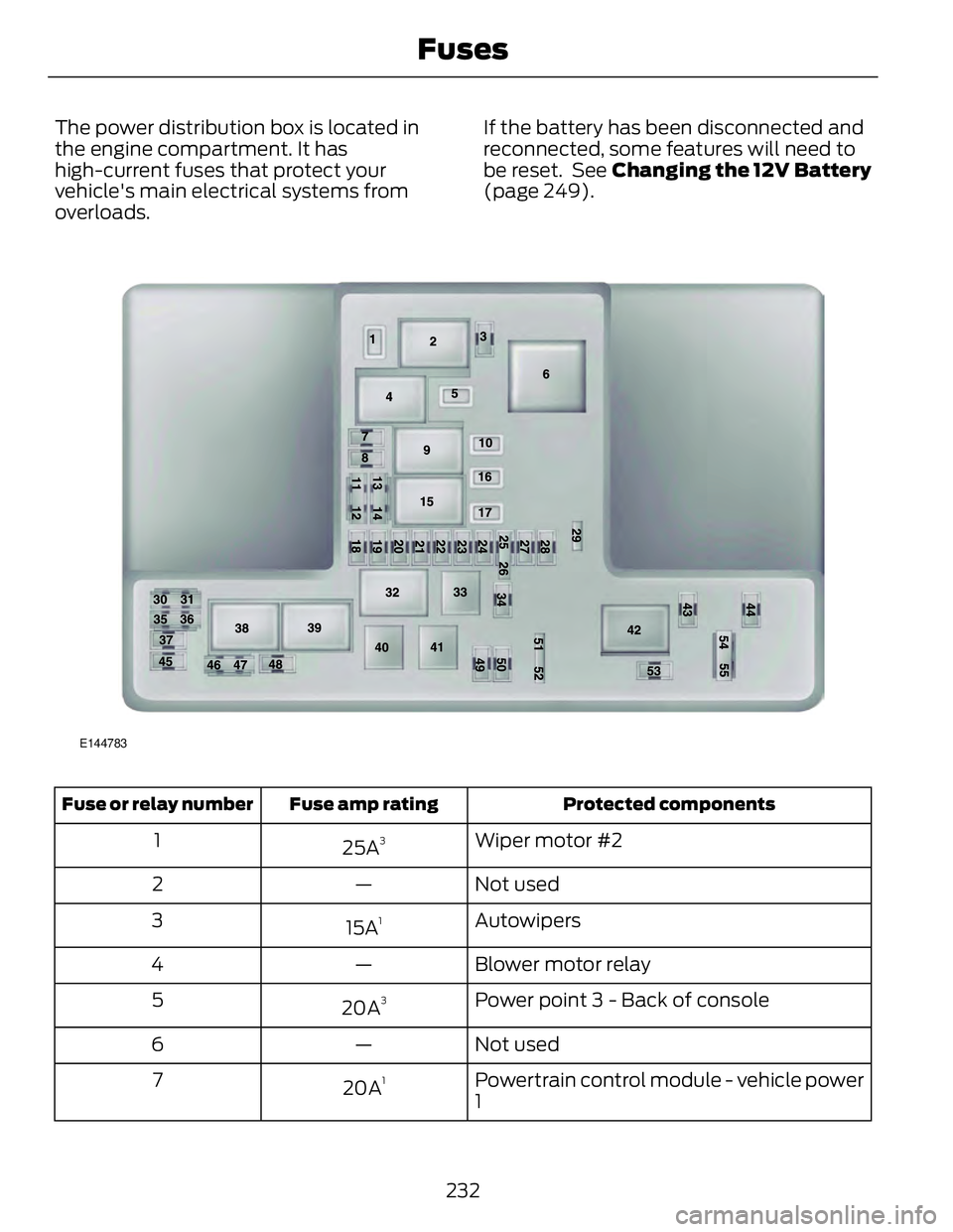
The power distribution box is located in
the engine compartment. It has
high-current fuses that protect your
vehicle's main electrical systems from
overloads. If the battery has been disconnected and
reconnected, some features will need to
be reset. See Changing the 12V Battery
(page 249).
E144783
Protected componentsFuse amp ratingFuse or relay number
Wiper motor #2
25A 3
1
Not used—2
Autowipers
15A 1
3
Blower motor relay—4
Power point 3 - Back of console
20A 3
5
Not used—6
Powertrain control module - vehicle power
120A 1
7
232Fuses
Page 236 of 473
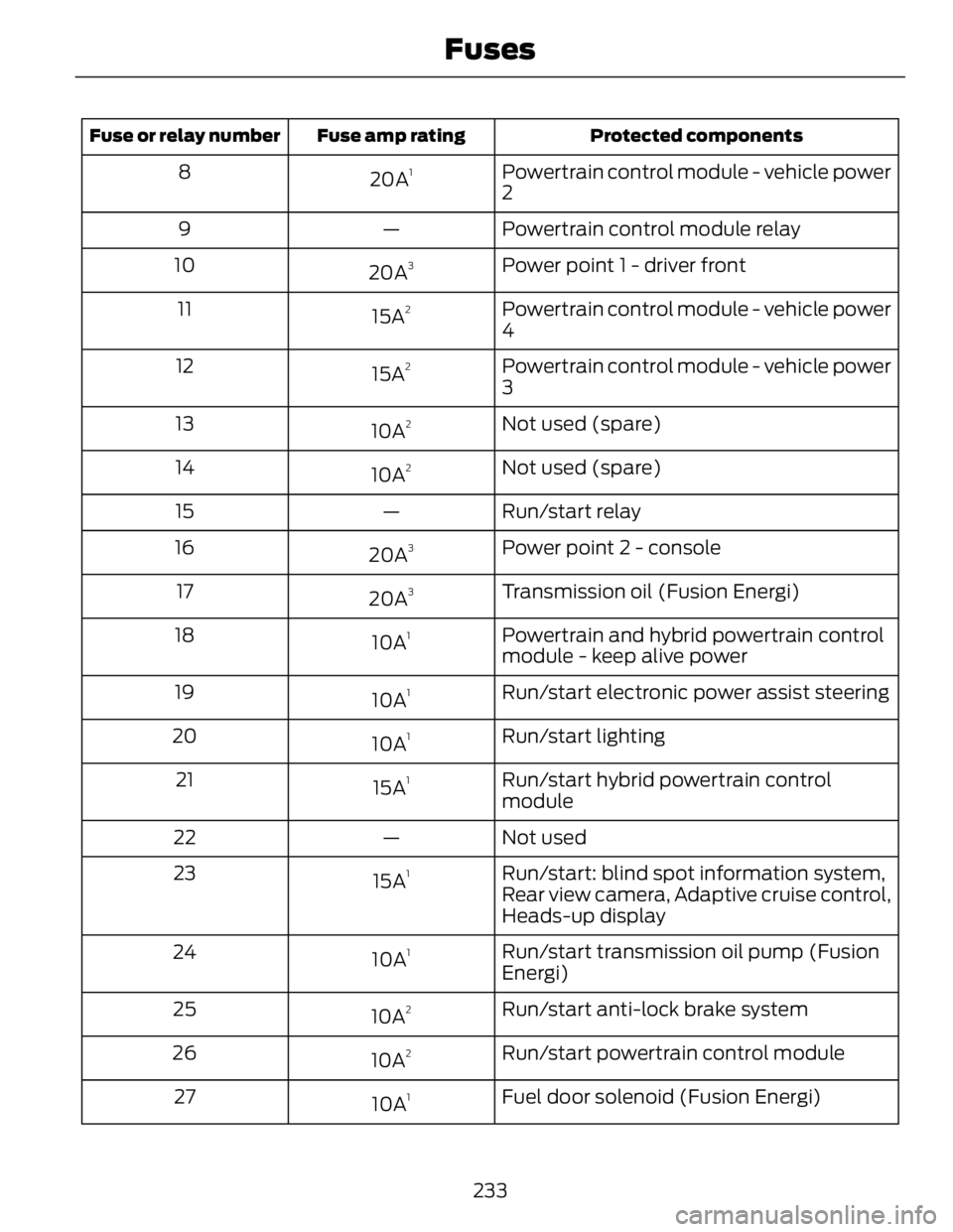
Protected componentsFuse amp ratingFuse or relay number
Powertrain control module - vehicle power
220A 1
8
Powertrain control module relay—9
Power point 1 - driver front
20A 3
10
Powertrain control module - vehicle power
415A 2
11
Powertrain control module - vehicle power
315A 2
12
Not used (spare)
10A 2
13
Not used (spare)
10A 2
14
Run/start relay—15
Power point 2 - console
20A 3
16
Transmission oil (Fusion Energi)
20A 3
17
Powertrain and hybrid powertrain control
module - keep alive power10A 1
18
Run/start electronic power assist steering
10A 1
19
Run/start lighting
10A 1
20
Run/start hybrid powertrain control
module15A 1
21
Not used—22
Run/start: blind spot information system,
Rear view camera, Adaptive cruise control,
Heads-up display15A 1
23
Run/start transmission oil pump (Fusion
Energi)10A 1
24
Run/start anti-lock brake system
10A 2
25
Run/start powertrain control module
10A 2
26
Fuel door solenoid (Fusion Energi)
10A 1
27
233Fuses
Page 237 of 473
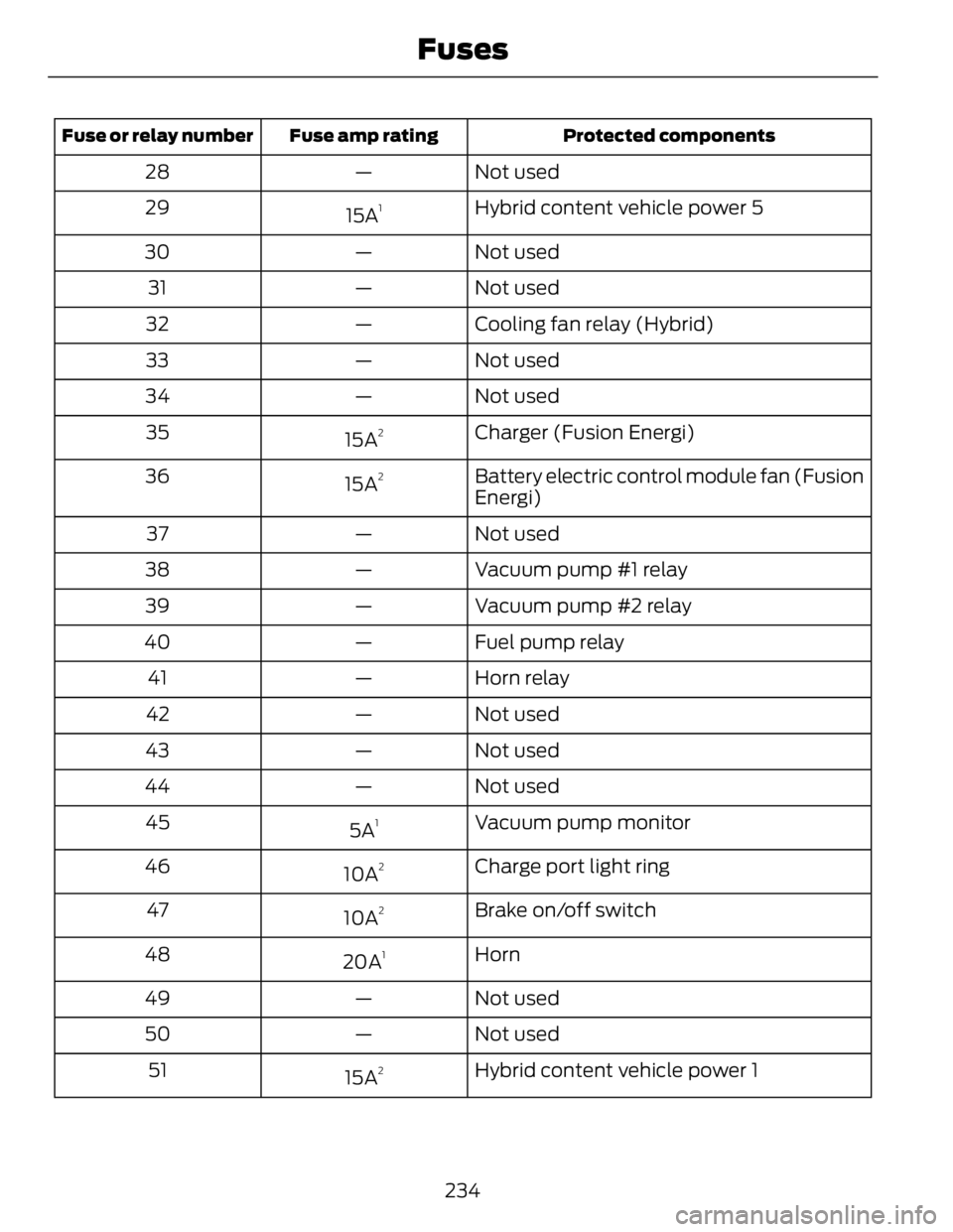
Protected componentsFuse amp ratingFuse or relay number
Not used—28
Hybrid content vehicle power 5
15A 1
29
Not used—30
Not used—31
Cooling fan relay (Hybrid)—32
Not used—33
Not used—34
Charger (Fusion Energi)
15A 2
35
Battery electric control module fan (Fusion
Energi)15A 2
36
Not used—37
Vacuum pump #1 relay—38
Vacuum pump #2 relay—39
Fuel pump relay—40
Horn relay—41
Not used—42
Not used—43
Not used—44
Vacuum pump monitor
5A 1
45
Charge port light ring
10A 2
46
Brake on/off switch
10A 2
47
Horn
20A 1
48
Not used—49
Not used—50
Hybrid content vehicle power 1
15A 2
51
234Fuses
Page 238 of 473
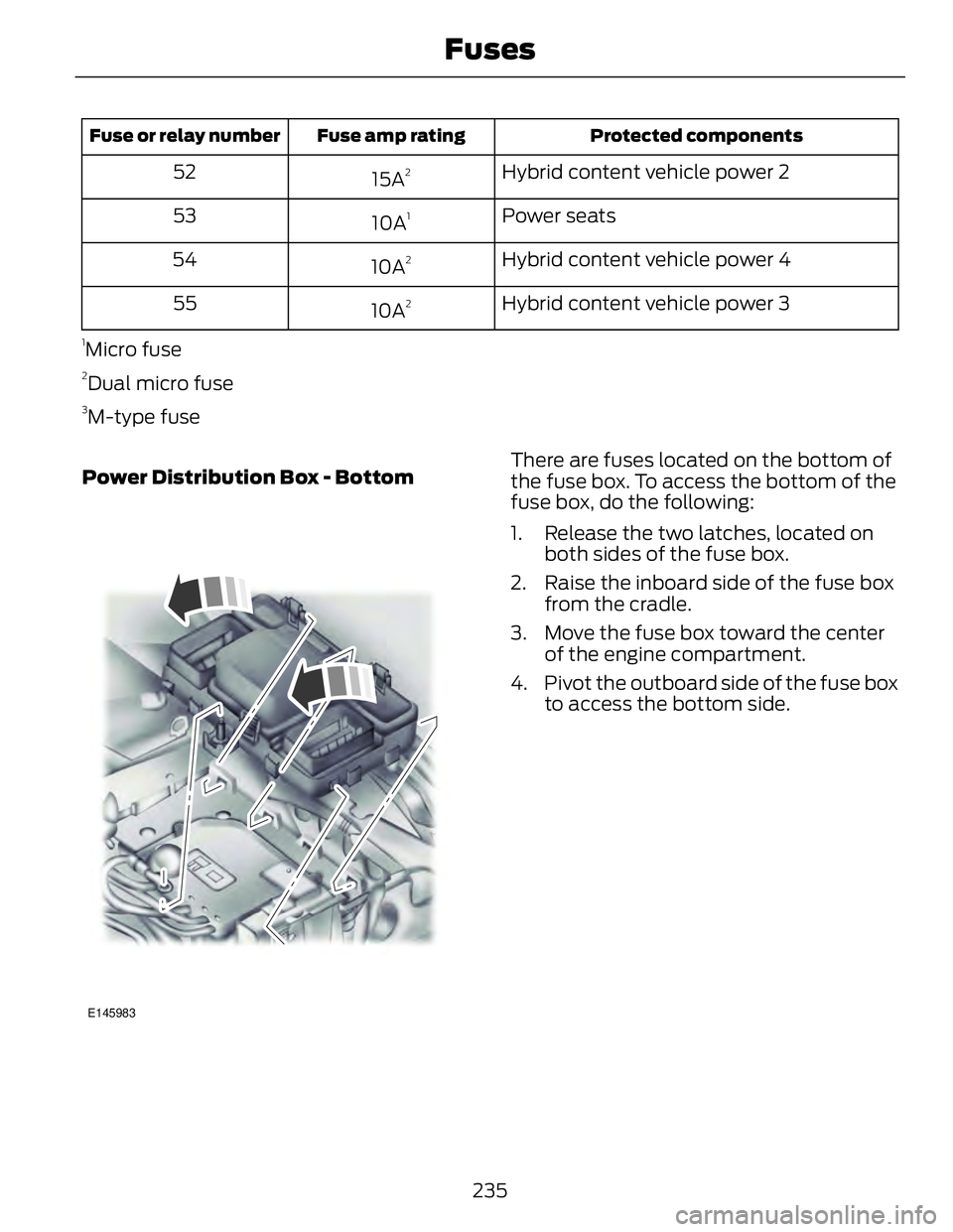
Protected componentsFuse amp ratingFuse or relay number
Hybrid content vehicle power 2
15A 2
52
Power seats
10A 1
53
Hybrid content vehicle power 4
10A 2
54
Hybrid content vehicle power 3
10A 2
551
Micro fuse 2
Dual micro fuse 3
M-type fuse
Power Distribution Box - Bottom
E145983 There are fuses located on the bottom of
the fuse box. To access the bottom of the
fuse box, do the following:
1. Release the two latches, located on
both sides of the fuse box.
2. Raise the inboard side of the fuse box
from the cradle.
3. Move the fuse box toward the center
of the engine compartment.
4. Pivot the outboard side of the fuse box
to access the bottom side.
235Fuses
Page 239 of 473

E144949
Protected componentsFuse amp ratingFuse or relay number
Fuel pump feed
30A 1
56
Not used—57
Not used—58
Vacuum pump relay
40A 1
59
PWM fan
40A 1
60
Not used—61
Body control module 1
50A 2
62
Not used—63
Charger B+ output (Fusion Energi)
40A 1
64
Front heated seat
20A 1
65
236Fuses
Page 240 of 473

Protected componentsFuse amp ratingFuse or relay number
Not used—66
Body control module 2
50A 2
67
Heated rear window
40A 1
68
Anti-lock brake system valves
30A 1
69
Passenger seat
30A 1
70
Not used—71
Not used (spare)
30A 1
72
Not used (spare)
20A 1
73
Driver seat module
30A 1
74
Not used—75
Not used (spare)
20A 1
76
Not used (spare)
30A 1
77
Not used—78
Blower motor
40A 1
79
Not used (spare)
30A 1
80
110 volt inverter
40A 1
81
Anti-lock brake system pump
60A 2
82
Wiper motor #1
25A 1
83
Not used—84
Not used (spare)
30A 1
851
M-type fuse 2
J-type fuse
237Fuses